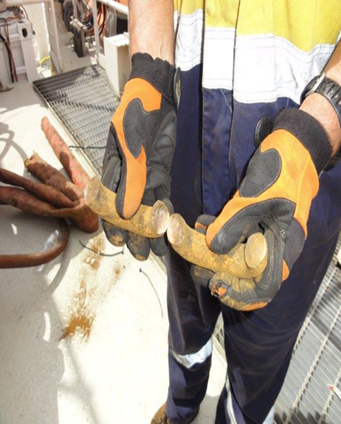Near-miss: Broken chain on self-propelled hyperbaric lifeboat (SPHL) recovery rigging
What happened?
A self-propelled hyperbaric lifeboat (SPHL) was being lifted to the main deck for an hyperbaric reception facility (HRF) mating trial. During this activity, the aft lifting chain on the SPHL broke whilst transferring the weight of the SPHL from the davits to the crane. The SPHL was approximately 50mm clear of the cradle when the aft chain snapped. At the time of the incident the crane reported an 8 tonne load. The dry weight of the SPHL was 13 tonnes. No persons were in the SPHL or in the immediate vicinity at the time of the incident. There were no injuries.

What went wrong? – Investigation and findings
- The rigging had been sent ashore for annual testing and failed on-board the vessel, shortly after it had been inspected by a 3rd party;
- The rigging was not tested as per 3rd party inspection procedures;
- The rigging was being stored outside in open environment – this will have contributed to the condition of the chain;
- A canvas sock around the rigging made it more difficult to inspect and see corrosion;
- A chain link failed at 2 positions and appears to not be deformed – indicating existing crack propagation.
What were the causes of the incident?
- Storage of the recovery rigging on top of SPHL exposed chain to the external environment – this contributed to the chain becoming corroded;
- Inspector checked lower links of the chain only and did not inspect the section hidden by the protective cover. The Inspector assumed that he had inspected sufficient percentage of the chain from which to infer the condition of the entire length. Chain under protective cover had significant corrosion.
What lessons were learnt? And what were the actions?
- All chain slings older than 12 months to be destroyed;
- SPHL recovery rigging to be stored below decks and fitted only when SPHL is required;
Audit to be conducted of 3rd party to ensure compliance with inspection procedures. Improved liaison and communication with 3rd party auditor.
Members may wish to refer to the following incidents:
Near-miss: Broken chain on sling of personnel lifting basket
Safety Event
Published: 9 June 2017
Download: IMCA SF 14/17
IMCA Safety Flashes
Submit a Report
IMCA Safety Flashes summarise key safety matters and incidents, allowing lessons to be more easily learnt for the benefit of all. The effectiveness of the IMCA Safety Flash system depends on Members sharing information and so avoiding repeat incidents. Please consider adding safetyreports@imca-int.com to your internal distribution list for safety alerts or manually submitting information on incidents you consider may be relevant. All information is anonymised or sanitised, as appropriate.
IMCA’s store terms and conditions (https://www.imca-int.com/legal-notices/terms/) apply to all downloads from IMCA’s website, including this document.
IMCA makes every effort to ensure the accuracy and reliability of the data contained in the documents it publishes, but IMCA shall not be liable for any guidance and/or recommendation and/or statement herein contained. The information contained in this document does not fulfil or replace any individual’s or Member's legal, regulatory or other duties or obligations in respect of their operations. Individuals and Members remain solely responsible for the safe, lawful and proper conduct of their operations.
